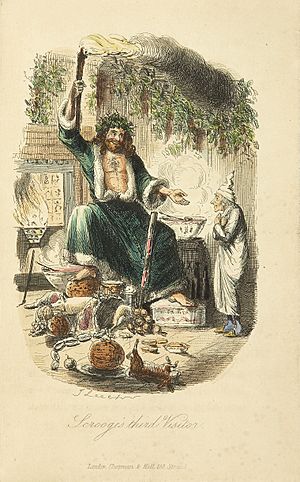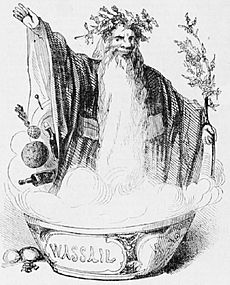Ghost of Christmas Present facts for kids

The Ghost of Christmas Present is one of three special Christmas spirits who visit Ebenezer Scrooge in the famous 1843 story A Christmas Carol. These spirits offer Scrooge a chance to change his ways and become a better person.
This Ghost appears in the third part of the story. The drawing by John Leech shows him looking a lot like early Victorian pictures of Father Christmas. He is like the spirit of Christmas itself, full of joy and generosity.
The Ghost of Christmas Present helps Dickens share his ideas about helping others and being kind, especially to people who are poor. He shows Scrooge the true meaning of Christmas: being generous and having good feelings toward everyone. This Spirit is very different from Scrooge, who is a miser (someone who loves money and hates spending it). The Ghost first appears to Scrooge sitting on a "throne" made of delicious Christmas foods. Each of the Christmas Ghosts shows Scrooge a different time. The Ghost of Christmas Present focuses on the Christmas Day happening right now in the story.
Contents
Why Dickens Wrote the Story

In 1843, Charles Dickens was very worried about how poor people were treated. He was especially upset about children working in terrible conditions, like in tin mines. He also visited schools for poor children, called "ragged schools." Dickens himself had been poor as a boy. He had to work in a factory when his father was put in prison for not paying his debts.
At first, Dickens wanted to write a serious article about helping poor children. But he changed his mind and wrote A Christmas Carol instead. This story allowed him to share his concerns about poverty and unfairness in a powerful way.
Dickens's friend and writer, John Forster, said that Dickens liked ghost stories, even if he didn't truly believe in ghosts. Dickens often included ghost stories in his magazines. In A Christmas Carol, Dickens made the idea of ghosts feel very real, as if they could exist in the world Scrooge lived in. The Christmas Spirits in the story show how much people in the early Victorian times were interested in strange and unexplained things.
Who is the Ghost of Christmas Present?
The Ghost of Christmas Present is described as a "jolly Giant." Leech's colorful drawing shows him as friendly and cheerful, with his hand open in a welcoming way. He looks like Father Christmas, an old figure linked to English Christmas. Father Christmas was often shown as a bearded giant wearing a green robe with fur, a holly crown, and holding mistletoe. He was usually surrounded by lots of food and drink. Pictures of Father Christmas became popular in magazines in the 1840s.
The American Santa Claus, from the 1822 poem A Visit from St. Nicholas, came from this English figure and Saint Nicholas of Myra, who gave gifts. But the Ghost of Christmas Present is not the same as the American Santa Claus, who was not well known in England until the 1850s.
What the Ghost Shows Scrooge
As Jacob Marley predicted, the Ghost of Christmas Present appears when the clock strikes one. Scrooge was ready for anything, but the Spirit's grand and joyful appearance still surprised him. It showed Scrooge how wonderful life could be, full of good things, if he chose to live differently.
Here's how Dickens describes the Ghost's first appearance:
The moment Scrooge's hand was on the lock, a strange voice called him by his name, and bade him enter. He obeyed...
Heaped up on the floor, to form a kind of throne, were turkeys, geese, game, poultry, brawn, great joints of meat, sucking-pigs, long wreaths of sausages, mince-pies, plum-puddings, barrels of oysters, red-hot chestnuts, cherry-cheeked apples, juicy oranges, luscious pears, immense twelfth-cakes, and seething bowls of punch, that made the chamber dim with their delicious steam. In easy state upon this couch there sat a jolly Giant, glorious to see; who bore a glowing torch, in shape not unlike Plenty's horn, and held it up, high up, to shed its light on Scrooge as he came peeping round the door.
"Come in!" exclaimed the Ghost. "Come in! and know me better, man!"
Scrooge entered timidly, and hung his head before this Spirit. He was not the dogged Scrooge he had been; and, though the Spirit's eyes were clear and kind, he did not like to meet them.
"I am the Ghost of Christmas Present," said the Spirit. "Look upon me!"
Scrooge reverently did so. It was clothed in one simple deep green robe, or mantle, bordered with white fur. This garment hung so loosely on the figure. Its feet, observable beneath the ample folds of the garment, were also bare; and on its head it wore no other covering than a holly wreath, set here and there with shining icicles. Its dark brown curls were long and free; free as its genial face, its sparkling eye, its open hand, its cheery voice, its unconstrained demeanour, and its joyful air. Girded round its middle was an antique scabbard; but no sword was in it, and the ancient sheath was eaten up with rust.
"You have never seen the like of me before!" exclaimed the Spirit.
Scrooge is much more humble with this Spirit than he was with the Ghost of Christmas Past. He says he is ready to learn any lesson the Spirit will teach him.
The Spirit takes Scrooge to the city streets that Dickens knew well. He shows Scrooge the joys and difficulties people face on Christmas Day. They visit a lively market, Christmas celebrations in a miner's home, a lighthouse, and Scrooge's nephew Fred's Christmas party.
A big part of this section of the story is about Bob Cratchit and his family. Even though they are poor, they love each other and enjoy being together. During their Christmas meal, we meet Cratchit's youngest son, Tiny Tim. Despite his illness, Tiny Tim is full of happiness and good spirit. The Ghost tells Scrooge that Tiny Tim will die if things don't change. This reminds Scrooge of his own harsh words earlier: "If he be like to die, he had better do it, and decrease the surplus population."
Scrooge notices that the Spirit, despite being huge, can fit anywhere easily. He stands gracefully under a low roof, just as he would in a grand hall. Some people see this as a hint to the idea that God came down to Earth in human form at Christmas.
Sunday Dinners for the Poor
The Ghost of Christmas Present shows Scrooge the dinners of poor people being cooked in a local bakery. At that time, many poor homes didn't have ovens. Scrooge, thinking the Spirit represents God, wrongly accuses him of wanting to close these bakeries on Sunday. This would mean poor people would have no hot food that day.
Dickens cared deeply about this issue. Some public figures wanted to keep Sunday very strict by stopping all non-religious work, including closing bakeries. Dickens wrote about this, arguing that such rules would only hurt the poor, who often had their only hot meal on Sundays. He believed that people should be judged by their good actions, not by strict religious rules that cause harm.
The Spirit tells Scrooge:
There are some on this earth of yours... who lay claim to know us, and who do their deeds of passion, pride, ill-will, hatred, envy, bigotry, and selfishness in our name, who are as strange to us and all our kith and kin, as if they had never lived. Remember that, and charge their doings on themselves, not us.
This means that some people claim to be religious but act in unkind ways. The Spirit tells Scrooge that these bad actions are their own fault, not the fault of true faith.
Ignorance and Want
As the Ghost's time with Scrooge runs out, he grows older. Before he disappears, Scrooge sees two terrible, thin children under the Spirit's robe. These are Ignorance and Want.
"Oh, Man! look here! Look, look, down here!" exclaimed the Ghost.
They were a boy and girl. Yellow, meagre, ragged, scowling, wolfish; but prostrate, too, in their humility.
Dickens included these two children as a warning to Scrooge and to everyone. He wanted to show the terrible results of ignoring the needs of the poor, especially poor children.
“Spirit! are they yours?” Scrooge could say no more.
“They are Man’s,” said the Spirit, looking down upon them. “And they cling to me, appealing from their fathers. This boy is Ignorance. This girl is Want. Beware them both, and all of their degree, but most of all beware this boy, for on his brow I see that written which is Doom, unless the writing be erased. Deny it!” cried the Spirit, stretching out its hand towards the city. “Slander those who tell it ye! Admit it for your factious purposes, and make it worse. And bide the end!”
“Have they no refuge or resource?” cried Scrooge.
“Are there no prisons?” said the Spirit, turning on him for the last time with his own words. “Are there no workhouses?”
The Spirit reminds Scrooge that poverty is a problem right now, not just in the past or future. He then uses Scrooge's own harsh words against him, asking if there are no prisons or workhouses for these children. The Spirit then disappears as midnight strikes.
Dickens repeated this warning about the poor in a speech he gave in 1844. He said that "Ignorance" is like a powerful spirit trapped in a bottle. If we release it in time, it will help society. But if we leave it trapped, its "blind revenge" will lead to destruction.
Who Has Played the Ghost of Christmas Present?
Many actors have played the Ghost of Christmas Present in movies, TV shows, and plays.
Film
- Richard L'Estrange in The Right to Be Happy (1916)
- Oscar Asche in Scrooge (1935)
- Lionel Braham in A Christmas Carol (1938)
- Francis de Wolff in Scrooge (1951)
- Kenneth More in Scrooge (1970)
- Felix Felton (voice) in A Christmas Carol (1971)
- Will Ryan (Willie the Giant) in Mickey's Christmas Carol (1983)
- Carol Kane in Scrooged (1988)
- Jerry Nelson (face and voice) in The Muppet Christmas Carol (1992)
- Whoopi Goldberg (voice) in A Christmas Carol (1997)
- Michael Gambon (voice) in Christmas Carol: The Movie (2001)
- Keith Wickham (voice) in A Christmas Carol (2006)
- Jim Carrey (voice and motion capture) in A Christmas Carol (2009)
- Justin Edwards in The Man Who Invented Christmas (2017)
- Daniel Kaluuya in A Christmas Carol (2020)
- Will Ferrell in Spirited (2022)
Television
- Les Tremayne (voice) in Mister Magoo's Christmas Carol (1962)
- Edward Woodward in A Christmas Carol (1984)
- Brian Cummings (voice) in A Flintstones Christmas Carol (1994)
- Desmond Barrit in A Christmas Carol (1999)
- Ray Fearon in A Christmas Carol (2000)
- Karen Gillan in the Doctor Who episode A Christmas Carol (2010)
- Andrea Libman in My Little Pony: Friendship Is Magic episode A Hearth's Warming Tail (2016)
- Charlotte Riley in A Christmas Carol (2019)
Musicals
- Stratford Johns in Scrooge (1992)
- Ken Jennings in A Christmas Carol (1994)
Plays
- Patrick Stewart (all characters) in A Christmas Carol (1991)
- Golda Rosheuvel / Nichola Hughes / Gloria Onitiri / Golda Rosheuvel / LaChanze in A Christmas Carol (2017-2021)
See also
 In Spanish: Fantasma de las Navidades Presentes para niños
In Spanish: Fantasma de las Navidades Presentes para niños



